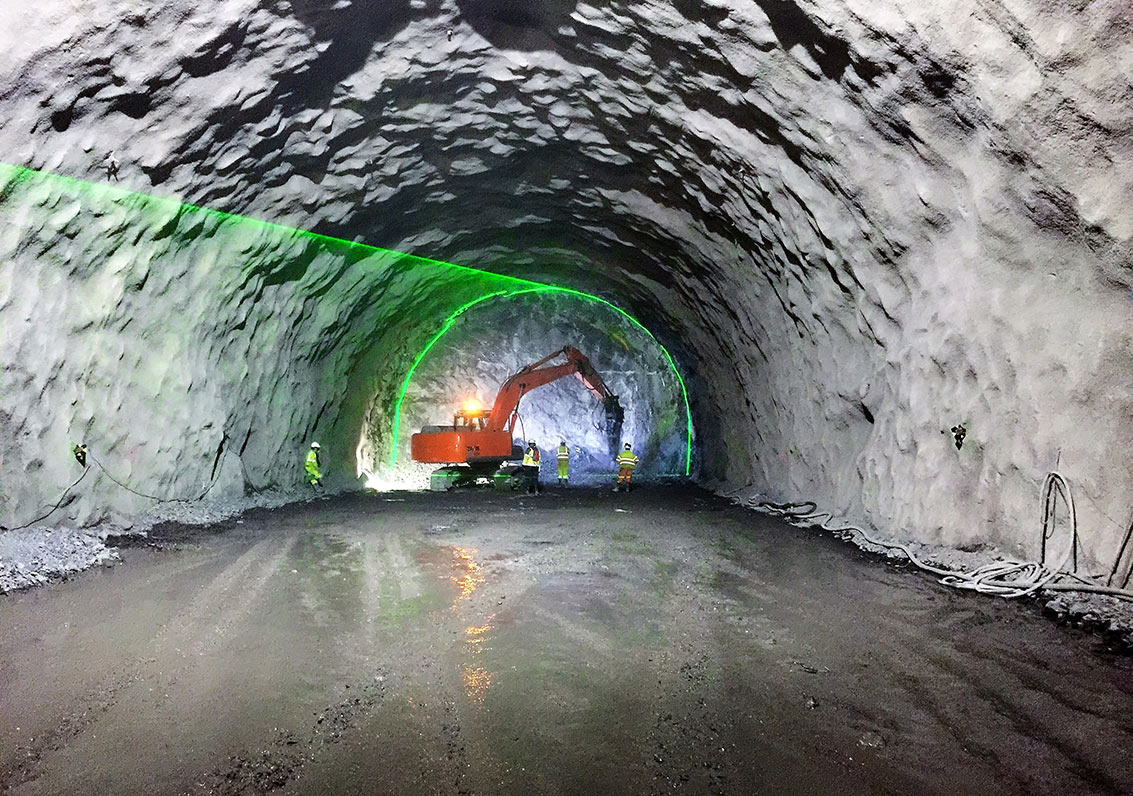Laser-guided profiling for conventional tunnelling 25 Nov 2020
In line with its commitment to innovation and sustainability, ACCIONA is applying laser and digital technologies to optimize the excavation and lining processes and achieve important environmental and sustainability goals.
One of the greatest challenges in conventional tunnelling is the control of geometrical deviations between the cross-section as designed and the cross-section as actually excavated. With the aim of reducing these deviations, ACCIONA has developed and patented a laser-guided system used during the excavation phase. The operation principle of the system consists of the continuous projection of the design cross-section onto the tunnel face, to provide a visual aid to the machine operators and tunnel engineers as a reference to reduce the geometrical deviations and optimize the excavation process. Application of the technology permits a reduction of the geometrical deviations in the cross-section by up to 50%, compared with other available methods.
The core of the innovation is the combination and integration of different subsystems into one piece of equipment. On the one hand, the hardware of the system consists of the combination of a topographic total station and a laser scanner; on the other hand, a proprietary software development controls the system, which it is fed by a database that contains all the constructive cross-sections associated with each measuring point along the tunnel advance. The operation of the system is user friendly, and makes possible its use by the production team or by non-qualified workers, without increasing the work of the surveyors for its use.
The practical applications of the system are the following:
- Tunnel cross-section control. The system allows the reducing of over-breaks by an automated adjustment of the actually excavated cross-section to that of the theoretical. In addition the time for the scaling process is reduced since there is no need to wait for the surveyor to arrive to identify the areas of under-break.
- Rockbolt pattern distribution. It allows reducing the time in this process because there is no need to mark the position of each bolt drill hole on the tunnel surface, as the theoretical bolt position and orientation is projected by the laser to guide the boom of the drill rig. The system also improves the axial distribution of each rockbolt in the pattern, enhancing the mechanical properties of this support.
- Scanning of the tunnel cross-section. After each excavation and primary lining cycle, it is possible to scan rapidly and easily the heading cross-section, reducing the effort of the surveying staff.
ACCIONA has successfully deployed this technology on several projects in Spain including the Padornelo railway and Olesa and Tres Ponts highway tunnels. There are plans also to use it on projects that ACCIONA will begin in 2021.
In addition to the advantages derived from the optimized performance of the excavation process, use of the technology also contributes to a reduction of CO2 emissions on the project. By controlling over-break in the cross-section, less material is excavated, less diesel is consumed as there is less transportation of material to the disposal area, and a smaller area for muck disposal is required. Significantly, less concrete is consumed for the secondary cast-in-situ final lining.
Due to the benefits provided, the system has been selected as a finalist in the category of Technical Innovation of the Year in the 2020 series of the International Tunnelling and Underground Space Association (ITA) Awards.
"ACCIONA remains committed to innovation on its projects,” commented Vara. “This laser technology is more versatile and effective than traditional methods of profile control and by improving the excavation and construction processes, it enhances control of the associated environmental impacts.”
References
- Finalists announced for ITA Awards 2020 – TunnelTalk, October 2020
- Acciona-Ghella selected for Broadway Subway project – TunnelTalk, July 2020
- Ecuador awards 22km metro construction – TunnelTalk, November 2015
|
|
|
|
|
Add your comment
- Thank you for taking the time to share your thoughts and comments. You share in the wider tunnelling community, so please keep your comments smart and civil. Don't attack other readers personally, and keep your language professional.



